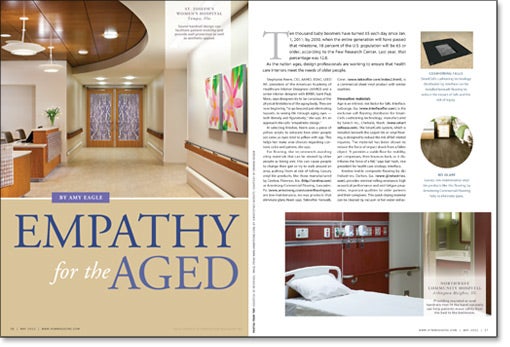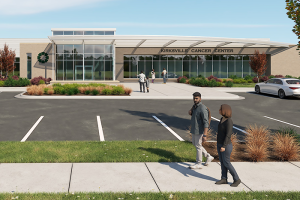Empathy for the Aged

Click the above image for a PDF download
Ten thousand baby boomers have turned 65 each day since Jan. 1, 2011; by 2030, when the entire generation will have passed that milestone, 18 percent of the U.S. population will be 65 or older, according to the Pew Research Center. Last year, that percentage was 12.8.
As the nation ages, design professionals are working to ensure that health care interiors meet the needs of older people.
Stephanie Reem, CID, AAHID, EDAC, LEED AP, president of the American Academy of Healthcare Interior Designers (AAHID) and a senior interior designer with BWBR, Saint Paul, Minn., says designers try to be conscious of the physical limitations of the aging body. They are now beginning "to go beyond just eliminating hazards, to seeing life through aging eyes — both literally and figuratively," she says. It's an approach she calls "empathetic design."
In selecting finishes, Reem uses a piece of yellow acrylic to simulate how older people see color, as eyes tend to yellow with age. This helps her make wise choices regarding contrast, color and pattern, she says.
For flooring, she recommends avoiding shiny materials that can be viewed by older people as being wet; this can cause people to change their gait or try to walk around an area, putting them at risk of falling. Luxury vinyl tile products, like those manufactured by Centiva, Florence, Ala. (http://centiva.com) or Armstrong Commercial Flooring, Lancaster, Pa. (www.armstrong.com/commflooringna), are low-maintenance, no-wax products that eliminate glare, Reem says. Teknoflor, Norwalk, Conn. (www.teknoflor.com/index2.html), is a commercial sheet vinyl product with similar qualities.
Innovative materials
Age is an intrinsic risk factor for falls. Interface, LaGrange, Ga. (www.interfaceflor.com), is the exclusive soft flooring distributor for SmartCells cushioning technology, manufactured by Satech Inc., Chehalis, Wash. (www.smartcellusa.com). The SmartCells system, which is installed beneath the carpet tile or vinyl flooring, is designed to reduce the risk of fall-related injuries. The material has been shown to reduce the force of impact shock from a fallen object. "It provides a stable floor for mobility, yet compresses, then bounces back, as it distributes the force of a fall," says Gail Nash, vice president for health care strategy, Interface.
Kinetex textile composite flooring by J&J Industries, Dalton, Ga. (www.jjindustries.com), provides minimal rolling resistance, high acoustical performance and anti-fatigue properties, important qualities for older patients and their caregivers. This quick-drying material can be cleaned by vacuum or hot water extraction, is highly durable and has been tested to resist approximately 40 different stains typically found in hospitals, says Keith Gray, director of product innovation, J&J Industries. These include blood, urine, Betadine and hand sanitizer. Kinetex received an Innovation award at the 2012 NeoCon design exposition in Chicago; the product is scheduled to be released this summer.
Older people may find it difficult to read signs, increasing the importance of visual wayfinding cues in the environment. Flooring patterns can be used to differentiate hospital floors and services in a way that's easily understood, notes Stacy Walker, director of marketing communications, Milliken Floor Covering, Spartanburg, S.C. (www.millikencarpet.com).
According to Karyn Gayle, vice president of the health care market for lighting company Acuity Brands Inc., Atlanta, Ga. (www.acuity brands.com), older adults typically need three to four times the light as people in their 20s, due to changes in the eye that occur with age. Layers of light, including natural, overhead and wall-mounted lighting, are important, Gayle says. Light-emitting diode (LED) lights, which are generally simpler to adjust than legacy lighting systems, can provide a better patient experience with reduced energy costs and a longer product life, she adds.
She also notes the importance of nightlights in creating safe pathways between locations like the patient bed and the bathroom. Patients using wheelchairs or walkers may have a lower line of sight, requiring elements like emergency exit signs to be placed closer to the floor.
Good handrail design can facilitate patient mobility and provide wall protection and aesthetic appeal, says Jim McLain, general manager, C/S Eldercare Interiors, Brookfield, Wis. (www.c-sgroup.com/eldercare). According to Jennifer Michalski, national accounts, C/S, handrail design has evolved from flat-fronted handrails that offer a limited gripping surface, toward a more ergonomic rounded or oval shape that fits the hand more naturally. This design is especially helpful to people who are not using the handrail from a standing position, but are pulling their way along it in a wheelchair.
Full spectrum
"In pediatrics, we've done a fabulous job of creating environments that engage and lift the human spirit. We need to do that on the other end of the age spectrum, designing positive experiences that provide variety, discovery and stimulation for elderly patients," says Reem.
Earl Swensson Associates Inc. (ESa), Nashville, Tenn., worked toward this goal in a recent project for the Department of Veterans Affairs (VA) New Jersey Health Care System. David W. Minnigan, AIA, IIDA, LEED AP, master planner, senior designer, and principal, ESa, says the Heart of the Home project, a continuing care learning environment for staff, veterans and family members, is designed to provide a noninstitutional, homelike setting with pattern, lighting, color and contrast appropriate for older people.
The space is intended to provide a good environment for seniors, to encourage its use by veterans, says Ken L. Bowman, IIDA, ASID, LEED AP ID+C, EDAC, interior designer and interior design manager, ESa. According to Kenneth Mizrach, director, VA New Jersey Health Care System, the design allows staff to connect better with patients. This type of environment facilitates a transformation from a medical model of bedside care to relationship-based care, says Mary Therese Hankinson, RD, EDAC, patient-centered care coordinator, VA New Jersey Health Care System.
Jocelyn M. Stroupe, AAHID, IIDA, ASID, EDAC, principal, Cannon Design, Chicago, says the Facilities Guidelines Institute's forthcoming Guidelines for Design and Construction of Residential Health, Care, and Support Facilities will be a useful resource to help designers working in acute and ambulatory care to understand the specific needs of older patients. She sees a convergence occurring between residential care and acute care design.
As Martin Valins, RIBA, associate AIA, principal, Stantec, Philadelphia, points out, "If you design only for active people, you exclude elderly people. If you design for the elderly, you include everyone. Everyone benefits."
"The objective is to reduce lengths of stay and improve outcomes. Designing for elders brings a greater sensitivity to how a patient experiences a hospital setting," says Barbara Miszkiel, principal, Stantec. "It's a universal solution, which is good for health care delivery in general."




